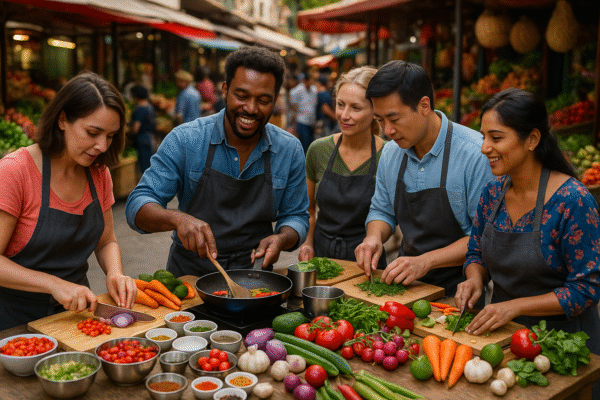The modern traveler increasingly seeks more than sightseeing—they crave immersive, hands-on food experiences. Culinary tourism has rapidly evolved into a multi-billion-dollar industry, with significant growth projected in the coming decade. This thriving industry centers on cooking classes, farm-to-table journeys, food festivals, and gastronomic trails connecting travelers to cultures and communities.
Hands-On Cooking Classes: Building Bonds Over Broth
Around the globe, travelers participate in intimate cooking classes led by local chefs and home cooks, forming lasting connections through shared recipes. In New York City, experiences invite visitors into home kitchens, where cooks from diverse cultural backgrounds share authentic recipes and personal stories. In Southeast Asia, travelers learn the delicate balance of spices and flavors central to regional cuisines, while workshops in Bangkok emphasize sustainable culinary practices.
These hands-on experiences foster cultural understanding and skill-sharing, turning ordinary vacationers into passionate culinary enthusiasts and ambassadors of international cuisine.
UNESCO, Culinary Heritage, and Education
UNESCO has significantly bolstered culinary tourism by recognizing culinary traditions as part of the world’s intangible cultural heritage. Recently, food traditions such as Spanish Asturian cider-making and Korean jang sauce preparation have gained international recognition, encouraging travelers to explore these culinary arts firsthand. Workshops and seminars, notably in Southeast Asia, are designed to integrate culinary practices with sustainability, further supporting the industry’s ethical growth.
Professional culinary bodies and institutes are also playing pivotal roles. Organizations such as the World Food Travel Association advocate for certified culinary guides, emphasizing the educational aspects of culinary tourism. Culinary awards celebrate excellence and innovation within the industry, motivating further development. Prestigious institutions, notably Spain’s Basque Culinary Center, bridge food education with travel, attracting international students keen on mastering gastronomy and culinary innovation.
Global Markets: Diverse Regions, Unified Appetite
- Asia-Pacific: Dominates the culinary tourism scene with vibrant street food experiences, cooking classes, and culinary tours in popular destinations like India, Japan, Thailand, Korea, China, and Malaysia. This region attracts food travelers eager for authentic and diverse gastronomic experiences.
- Europe: Holds a substantial portion of the global culinary tourism market, renowned for its deep-rooted food heritage, Michelin-starred dining experiences, unique events like truffle hunts, wine tours, and internationally acclaimed food festivals, including Oktoberfest and Salon du Chocolat.
- North America: Culinary tourism thrives through farm-to-table experiences, cooking retreats, and notable food festivals such as the Napa Valley wine celebrations and New Orleans’ Jazz & Heritage Festival. Social media significantly amplifies these experiences, especially among younger travelers seeking visually appealing, authentic encounters.
- Caribbean: Jamaica recently launched a culinary certification program aimed at enhancing chef skills and elevating the island’s reputation as a culinary destination, blending local ingredients and traditions with international culinary standards.
- Africa and South America: These regions offer untapped culinary potential. Travelers are increasingly discovering experiences such as Ethiopian coffee ceremonies, Ghanaian cultural food tours, and the unique fusion cuisines of Peru, which blend Andean traditions with European influences.
Culinary Competitions and Chef-Led Journeys
International culinary events, such as Germany’s Culinary Olympics and India’s Young Chef Olympiad, place global culinary talent on prominent stages, enabling cross-cultural exchanges and learning opportunities.
Additionally, chef-led culinary tours have surged in popularity. Exclusive cooking retreats, such as those led by renowned chefs in exotic locations like Kenya’s wilderness, blend culinary education with luxury and sustainability, providing travelers with unforgettable gastronomic and natural experiences.
Sustainability and Digital Innovation
The growth of culinary tourism is also bringing challenges, notably seasonal fluctuations and increased costs. However, sustainability is increasingly at the forefront, with an emphasis on farm education, local sourcing, and waste reduction initiatives.
Digital advancements significantly enhance culinary tourism, with platforms like Airbnb Experiences and Google Travel offering accessible, personalized cooking sessions, market tours, and virtual tastings. Social media’s impact continues to grow, propelling culinary destinations and experiences to instant global recognition. Millennials and Gen Z travelers are particularly influential, prioritizing authenticity, sustainability, and visually engaging experiences.
Conclusion: A United Table and Global Movement
Culinary tourism transcends geographical boundaries, bringing people together through shared recipes, cooking techniques, and cultural appreciation. From UNESCO heritage traditions and professional culinary training to immersive cooking classes and chef-led wilderness adventures, culinary tourism fosters a global community united by food.
As the culinary tourism market continues its robust growth, destinations investing in cultural authenticity, culinary education, and sustainability will emerge as global leaders. The future of travel lies in meaningful culinary connections, fostering global unity—one delicious bite at a time.
Read more exclusive news, follow Global Travel Wire.
Disclaimer: This image is AI generated and may bear no resemblance with actual fact or images.















